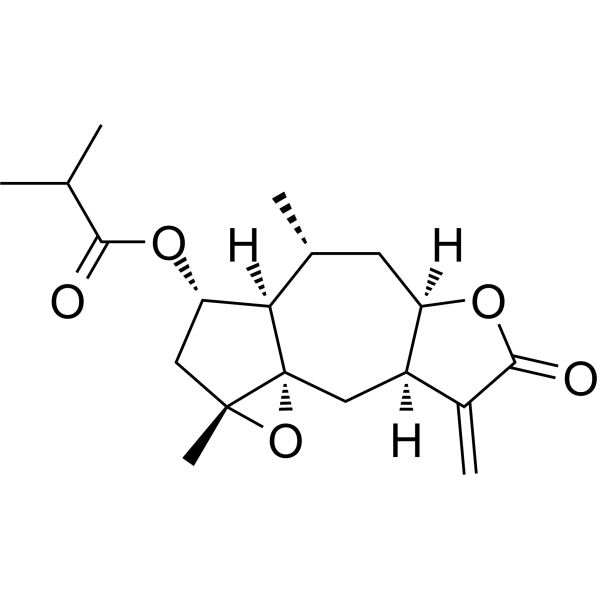
Minimolide F
CAS No. 1367351-41-4
Minimolide F( —— )
Catalog No. M29324 CAS No. 1367351-41-4
Minimolide F, isolated from Centipeda minima, shows antiproliferative activity against human nasopharyngeal cancer cells with an IC50 of 17.4 μM.
Purity : >98% (HPLC)
 COA
COA
 Datasheet
Datasheet
 HNMR
HNMR
 HPLC
HPLC
 MSDS
MSDS
 Handing Instructions
Handing Instructions
| Size | Price / USD | Stock | Quantity |
| 2MG | 218 | Get Quote |


|
| 5MG | 335 | Get Quote |


|
| 10MG | 537 | Get Quote |


|
| 25MG | 842 | Get Quote |


|
| 50MG | 1134 | Get Quote |


|
| 100MG | Get Quote | Get Quote |


|
| 200MG | Get Quote | Get Quote |


|
| 500MG | Get Quote | Get Quote |


|
| 1G | Get Quote | Get Quote |


|
Biological Information
-
Product NameMinimolide F
-
NoteResearch use only, not for human use.
-
Brief DescriptionMinimolide F, isolated from Centipeda minima, shows antiproliferative activity against human nasopharyngeal cancer cells with an IC50 of 17.4 μM.
-
DescriptionMinimolide F, isolated from Centipeda minima, shows antiproliferative activity against human nasopharyngeal cancer cells with an IC50 of 17.4 μM.
-
In VitroMinimolide F has antiproliferative activity and can inhibit the CNE cell growth.
-
In Vivo——
-
Synonyms——
-
PathwayOthers
-
TargetOther Targets
-
Recptor——
-
Research Area——
-
Indication——
Chemical Information
-
CAS Number1367351-41-4
-
Formula Weight334.41
-
Molecular FormulaC19H26O5
-
Purity>98% (HPLC)
-
Solubility——
-
SMILESC[C@]12[C@]3([C@@]([C@@H](OC(C(C)C)=O)C1)([C@H](C)C[C@@]4([C@](C3)(C(=C)C(=O)O4)[H])[H])[H])O2
-
Chemical Name——
Shipping & Storage Information
-
Storage(-20℃)
-
ShippingWith Ice Pack
-
Stability≥ 2 years
Reference
molnova catalog



related products
-
Pyrocurzerenone
Pyrocurzerenone is a natural product for research related to life sciences.
-
Isocarlinoside
Isocarlinoside, L-malic acid, trans-aconitic acid, (+)-isocitric acid , 5-O-caffeoylquinic acid, 4-O-caffeoylquinic acid, 2"-O-rhamnosylisoorientin, and 7-O-(2"-O-glucuronosyl)glucuronosyltricin showed high antifeeding activity against brown planthopper only when they were combined.
-
Foslinanib
Foslinanib (TRX-818) is an orally bioavailable agent with potential antineoplastic and anti-vasculogenic mimicry (VM) activities.



 Cart
Cart
 sales@molnova.com
sales@molnova.com


